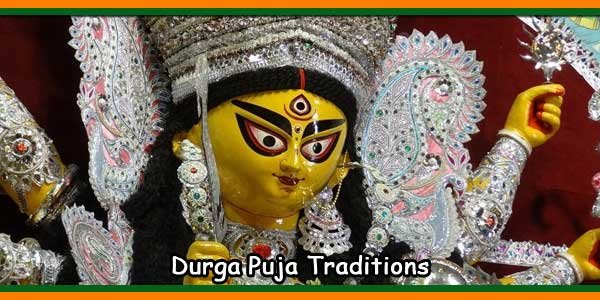Celebrating Durga Puja with your family, also tell your children about these eight interesting traditions that will help them better understand our rich cultural history.
Durga, Jagdamba or Mahishasura Mardini, whatever name you call her or the adores, the goddess Durga is an embodiment of shakti, courage, love and care. A powerful goddess who can defeat the demons with one hand and a mother who dedicates everything to her children.
Maa Durga or simply Maa, as her followers call her with love, is one of the fiercest and most worshiped deities in the Hindu religion. While East India is famous for the festivities of Durga Puja, the deity is worshiped in various forms throughout India during the nine-day Navaratri festival.
In this Durga Puja, we share with you lesser known facts about the goddess and the traditions associated with the festivities.
1) According to tradition, the idol or pratima of Durga is made of clay and the gods and goddesses who accompany it (four in number) are called ek chala (a blanket). It is supposed that the eyes of the goddess are painted at the end and in the most complete darkness, in the presence of a single sculptor. This important ritual is called Chokku daan (which offers eyes) and is one of the most moving moments for the sculptor who spends months creating the practices. The ceremony of Chokku daan marks the beginning of the journey of the Divine Mother into the world of mortals.
2) The soil or clay used to make idols is collected on the banks of the Ganges, or Hooghly, as it is known in West Bengal. However, the clay must also be mixed with soil from nishiddho palli or prohibited areas, one of which is the yard of a courtesan’s house. According to folklore, a priest must visit the courtesan and pray for punya matti (pure land). The reason behind this tradition is that the Divine Mother does not distinguish between her children. Therefore, Durga Puja is sarbajanin, which is for everyone. And, this spirit is evident as individuals from every segment of society come together to celebrate.
3) In Northern India, Durga Puja is celebrated under the name of Navaratri. It is believed that Lord Rama worshiped Mahishasura Mardini (another name of the goddess Durga) before making war on the demon king Ravana. He offered 108 blue lotuses and lit 108 lamps in honor of Maa Durga.
4) Goddess Durga is believed to bring prosperity, peace and happiness to the world. But the mode of transportation or vaahan by which she choose to arrive and depart is also of great importance. Besides the lion, the elephant, the horse, the boat and the palanquin are the other vaahans of Maa Durga. She arrives in a vaahan and leaves in another. Her choice of vaahan for arrival and departure indicates how the next year will go for the world.

5) Durga Puja is celebrated for five days. These are the most important days of the festival: ashtami, navami and dashami (eighth, ninth and tenth). However, since Hindus also follow the lunar calendar and the most auspicious days or tithis are based on the increasing and decreasing phases of the moon, the days of Navaratri do not follow the traditional 24-hour cycle. A new tithi Navaratri can also start at night and is welcome with arati, dhak and dhunuchi naach.
6) The feasts of Durga Puja were initiated by the landowners or zamindars of Dinajpur and Malda between the late sixteenth and early seventeenth century. In 1790, 12 friends (baro-yaari) of Guptipara, in the district of Hooghly, in West Bengal, collect contributions from the inhabitants for the puja. It started the Sarbajanin tradition or community puja. In Calcutta/Kolkata, the puja was held for the first time in 1909.
7) The idol of Maa Durga is decorated with great care and love and has its own story. The pratima is decorated with sholar shaaj or daaker shaaj. In Shalar Sholar shaaj, the idol is decorated with the white core of shola pith (Indian cork). The tradition of the daaker shaaj began when the rich devotees had the idea of decorating the idol with a silver leaf. It had to be imported from Germany by post or daak, and so the name of daaker shaaj appeared.
8) With Maa Durga and her four children, Lord Ganesha’s wife is also worshipped during Durga Puja. Next to Lord Ganesha is Kola Bou (wife of the tree) or a banana plant wrapped in a white sari with a red border and is placed beside Lord Ganesha. On the seventh day (Saptami), the kola bou is bathed and revered as a goddess.
Each Indian festival is intrinsically linked to culture and tradition. In this Durga Puja, share these amazing facts with your child to help her better understand his culture and heritage.

